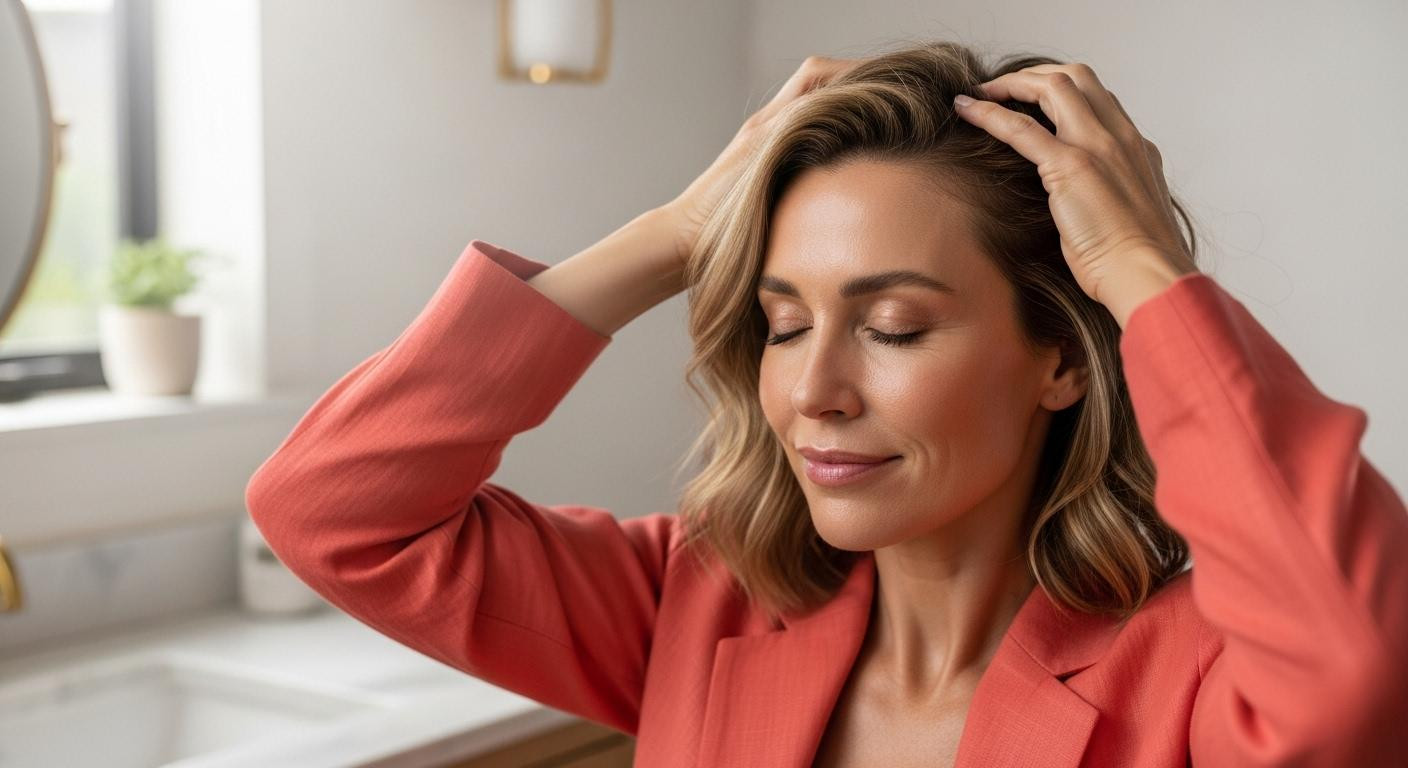Your mirror reflects a truth many women over 45 recognize. The part widens slightly each morning. Crown volume disappears overnight. Hair feels thinner between your fingers. But trichologists studying follicle aging reveal a different story. Your hair isn’t simply falling out. It’s aging at a cellular level, producing finer strands through predictable biological mechanisms. Understanding these pathways unlocks validated solutions that reverse follicular miniaturization in just 8 weeks.
Why your hair follicles produce thinner strands after 45
Hair follicle stem cells age just like skin cells. They exhibit enhanced resting phases and abbreviated growth cycles. Research published in aging journals confirms this cellular decline creates visible thinning.
The anagen growth phase shrinks dramatically with age. Young women enjoy 3-5 year growth cycles. By 50, many follicles produce hair for only 1-2 years. Fewer growth cycles mean fewer opportunities for thick, healthy strands.
Follicular miniaturization follows this timeline. Each cycle produces slightly finer hair. After 5-7 growth cycles, terminal follicles transform into vellus-like structures. They create barely visible strands instead of robust hair.
Sebum production compounds the problem. Women lose 40-50% of natural oil production during menopause. Hair appears dull and brittle without protective sebaceous coating. This isn’t hair loss but hair transformation.
The hormonal shift that accelerates thinning during menopause
How estrogen protects hair follicles
Estrogen prolongs the anagen phase through anti-apoptotic effects. It inhibits programmed cell death in hair matrix keratinocytes. Declining estrogen during perimenopause removes this protective shield.
Clinical data shows 15-20% annual density loss in the first two years post-menopause. This accelerated thinning reflects dramatic estrogen decline. The follicle loses its primary growth-promoting hormone.
The cortisol connection you’re overlooking
Chronic stress elevates cortisol levels significantly. This hormone shortens anagen phases by 30-40% through direct matrix cell effects. Stressed individuals show 2.5 times higher inflammatory markers in scalp tissue.
Cortisol disrupts hair follicle immune privilege. This triggers premature catagen phases. Natural oils can help counteract stress-induced inflammation through anti-inflammatory pathways.
3 scalp mechanisms you can reverse in 8 weeks
Boosting microcirculation through daily massage
Scalp blood flow declines 70% from age 20 to 70. Laser Doppler studies measure only 12-15 mL/min/cm² in seniors versus 35-40 mL/min/cm² in young adults. Follicles starve without adequate circulation.
Daily massage reverses this decline measurably. Five minutes of moderate pressure increases blood flow by 45% after 12 weeks. Clinical trials show 18.5% density improvement after 6 months of consistent massage.
The technique matters critically. Use fingertip pressure only, not mechanical devices. Professional scalp care routines emphasize gentle stimulation over aggressive manipulation.
Anti-inflammatory ingredients that support follicle health
Rosemary oil contains 2.5-3.5% carnosic acid, which inhibits 5-alpha-reductase similarly to minoxidil. Double-blind studies show 22% density improvement after 6 months versus 15% for placebo groups.
Peptide serums work through different mechanisms. Copper peptides stimulate 20% increased collagen production in dermal sheaths at 12 weeks. Biomimetic peptides reduce inflammatory markers by 35%.
Price ranges span $10-88 for effective serums. Combining topical treatments with strategic styling maximizes visible thickness improvements.
Why volumizing shampoos work but won’t permanently thicken
Volumizing products create temporary optical fullness through shaft swelling. They coat individual strands with polymers that increase apparent diameter. Effects last 12-24 hours maximum.
These products complement biological treatments effectively. Shampoos provide immediate styling benefits while serums address long-term follicle health. Cosmetic chemists with expertise in active ingredients confirm this dual approach works best.
Strategic cuts enhance the illusion of thickness when combined with volumizing formulas. The combination creates measurable visual improvement.
Your questions about hair thickness and aging answered
Does minoxidil actually regrow hair or just slow loss?
Minoxidil produces genuine regrowth in early-stage thinning. Clinical trials show 18-22% density improvement at 6 months in men and 15-18% in women over 45. Results require 6 months for visibility and lifelong use for maintenance.
Can I damage my scalp by massaging too aggressively?
Sharp tools can damage follicles and create inflammation. Fingertips provide optimal pressure without injury risk. Moderate pressure stimulates circulation effectively. Excessive force triggers inflammatory responses that worsen thinning.
Which is more effective natural oils or clinical-grade serums?
Head-to-head studies show rosemary oil achieving 16.8% density improvement versus 18.4% for minoxidil 2% at 6 months. Both require consistent application. Clinical serums show slightly superior results but natural options provide significant benefits at lower cost.
Six months later, your morning routine includes automatic scalp massage. The serum bottle sits half-empty on your bathroom counter. Your mirror reflects denser growth at the crown, fuller volume through the part. Not dramatic transformation, but visible maintenance. Hair aging responds to patient, consistent intervention.
